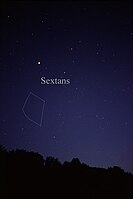Sextans
| Constellation | |
 | |
| Abbreviation | Sex |
|---|---|
| Genitive | Sextantis, Sextansis |
| Pronunciation | /ˈsɛkstənz/, genitive /sɛksˈtænt[invalid input: 'ɨ']s/ |
| Symbolism | the Sextant |
| Right ascension | 10 |
| Declination | 0 |
| Quadrant | SQ2 |
| Area | 314 sq. deg. (47th) |
| Main stars | 3 |
| Bayer/Flamsteed stars | 28 |
| Stars with planets | 5 |
| Stars brighter than 3.00m | 0 |
| Stars within 10.00 pc (32.62 ly) | 5 |
| Brightest star | α Sex (4.49m) |
| Messier objects | None |
| Meteor showers | Sextantids |
| Bordering constellations | Leo Hydra Crater |
| Visible at latitudes between +80° and −90°. Best visible at 21:00 (9 p.m.) during the month of April. | |
Sextans is a minor equatorial constellation which was introduced in 1687 by Johannes Hevelius. Its name is Latin for the astronomical sextant, an instrument that Hevelius made frequent use of in his observations.
Notable features
Sextans as a constellation covers a rather dim, sparse region of the sky. It has only one star above the fifth magnitude, namely α Sextantis at 4.49m. The constellation contains a few double stars, including γ, 35, and 40 Sextantis. There are a few notable variable stars, including β, 25, 23 Sextantis, and LHS 292. NGC 3115, an edge-on lenticular galaxy, is the only noteworthy deep-sky object. It also lies near the ecliptic, which causes the Moon, and some of the planets to occasionally pass through it for brief periods of time.
The constellation is the location of the field studied by the COSMOS project, undertaken by the Hubble Space Telescope.
Sextans B is a fairly bright dwarf irregular galaxy at magnitude 6.6, 4.3 million light-years from Earth. It is part of the Local Group of galaxies.[1]
In June 2015, astronomers reported evidence for Population III stars in the Cosmos Redshift 7 galaxy (at z = 6.60) found in the Sextans constellation. Such stars are likely to have existed in the very early universe (i.e., at high redshift), and may have started the production of chemical elements heavier than hydrogen that are needed for the later formation of planets and life as we know it.[2][3]
Gallery
-
The constellation Sextans as it can be seen by the naked eye. -
Sextans and other constellations seen aroundHydra. From Urania's Mirror (1825) -
Cosmos Redshift 7, brightest galaxy in the early universe, is located in the constellation Sextans (artist concept).
References
- ^ Levy 2005, p. 178.
- ^ Sobral, David; Matthee, Jorryt; Darvish, Behnam; Schaerer, Daniel; Mobasher, Bahram; Röttgering, Huub J. A.; Santos, Sérgio; Hemmati, Shoubaneh (4 June 2015). "Evidence For POPIII-Like Stellar Populations In The Most Luminous LYMAN-α Emitters At The Epoch Of Re-Ionisation: Spectroscopic Confirmation" (PDF). The Astrophysical Journal. 808: 139. arXiv:1504.01734. Bibcode:2015ApJ...808..139S. doi:10.1088/0004-637x/808/2/139. Retrieved 17 June 2015.
- ^ Overbye, Dennis (17 June 2015). "Astronomers Report Finding Earliest Stars That Enriched Cosmos". New York Times. Retrieved 17 June 2015.
- Levy, David H. (2005). Deep Sky Objects. Prometheus Books. ISBN 1-59102-361-0.
{{cite book}}: Invalid|ref=harv(help) - Ian Ridpath and Wil Tirion (2007). Stars and Planets Guide, Collins, London. ISBN 978-0-00-725120-9. Princeton University Press, Princeton. ISBN 978-0-691-13556-4.



